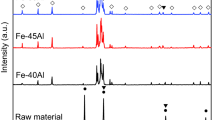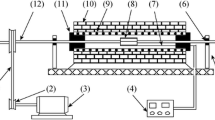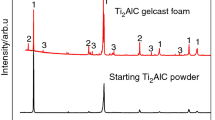Abstract
Gasarites are a subclass of metallic foams that have a cylindrical pore morphology created by directional solidification of metals saturated with a gas. Thermal decomposition is an alternative process in which the soluble gas is delivered by decomposition of a particulate gas source. Aluminum gasarites formed through decomposition of titanium and zirconium hydrides were studied to both replicate the results of a previous study and discern pore-formation mechanisms. Replication of the previous study was not achieved, and additional processing enhancements were required to produce gasarite pore morphologies. For the first time, zirconium hydride was utilized to produce gasarites, with porosity levels and pore sizes lower than that from titanium hydride. Maximum average porosity levels of 10 and 6 pct were observed for titanium hydride and zirconium hydride, respectively. Pore-formation mechanisms in aluminum gasarite foams created via thermal decomposition of titanium and zirconium hydrides were evaluated through metallographic analysis and scanning electron microscopy. Definitive evidence of gas–metal eutectic pore growth was not found, but pore morphological characteristics and chemical analysis of particulate at pore surfaces support direct gas evolution from the hydride particles as a contributor to pore formation and growth.







Similar content being viewed by others
References
V.I. Shapovalov and J.C. Withers: in MetFoam 2007, DEStech Publications Inc., Montreal, 2008.
H. Nakajima, Progress in Materials Science 2007, vol. 52, pp. 1091-1173.
Boyko L Shapovalov VI, Advanced Engineering Materials 2004, vol. 6, pp. 407-410.
L. Yuan and Y. X. Li, Scr. Mater. 2003, vol. 49, pp. 379-386.
L. Yuan, Y. X. Li and H. W. Zhang, Acta Metall Sin 2004, vol. 40, pp. 1121-1126.
L. Drenchev, J. Sobczak, S. Malinov and W. Sha, Mater. Sci. Technol. 2006, vol. 22, pp. 1135-1147.
T. Wada, T. Ide and H. Nakajima, Metallurgical and Materials Transactions A 2009, vol. 40, pp. 3204-3209.
J. S. Park and H. Nakajima, Journal of Physics: Conference Series 2009, vol. 165, p. 012066.
T. Ide and H. Nakajima, Journal of Physics: Conference Series 2009, vol. 165, p. 012064.
S. Y. Kim, J. S. Park and H. Nakajima, Metallurgical and Materials Transactions A 2009, vol. 40, pp. 937-942.
H. Nakajima, Advanced Engineering Materials 2008, vol. 10, pp. 816-819.
H. Nakajima and T. Ide, Metallurgical and Materials Transactions A 2008, vol. 39, pp. 390-394.
M. Tane and H. Nakajima, Journal of Physics: Conference Series 2009, vol. 165, p. 012065.
L. P. Lefebvre, J. Banhart and D. C. Dunand, Advanced Engineering Materials 2008, vol. 10, pp. 775-787.
M.F. Ashby, A.G. Evans, N.A. Fleck, L.J. Gibson, J.W. Hutchinson, and H.N.G Wadley: Metal Foams: A Design Guide, 1th ed., Butterworth Heinemann, Boston, 2000.
A. Makaya and H. Fredriksson, Int. J. Cast. Metals Res. 2007, vol. 20, pp. 73-83.
K. A. Terrani, M. Balooch, D. Wongsawaeng, S. Jaiyen and D. R. Olander, Journal of Nuclear Materials 2010, vol. 397, pp. 61-68.
M. T. Malachevsky and C. A. D’Ovidio, Scr. Mater. 2009, vol. 61, pp. 1-4.
G. Kaptay, Colloids and Surfaces A: Physicochemical and Engineering Aspects 2003, vol. 230, pp. 67-80.
K. D. Carlson, Z. Lin and C. Beckermann, Metallurgical and Materials Transactions B 2007, vol. 38, pp. 541-555.
Acknowledgments
The authors thank Professor David Dunand from the Northwestern University for supplying the zirconium hydride used in the current study, and Dr. Vladimir Shapovalov for his invaluable advice on Gasar processing.
Author information
Authors and Affiliations
Corresponding author
Additional information
Manuscript submitted January 14, 2013.
Rights and permissions
About this article
Cite this article
Licavoli, J.J., Sanders, P.G. Processing and Pore Growth Mechanisms in Aluminum Gasarites Produced by Thermal Decomposition. Metall Mater Trans A 45, 911–917 (2014). https://doi.org/10.1007/s11661-013-2037-8
Published:
Issue Date:
DOI: https://doi.org/10.1007/s11661-013-2037-8




